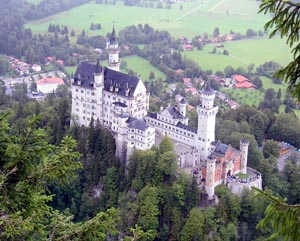
A castle built by Count Ludwig.
Dolomites
In September 2006 Martin and Morresa Meyer and I went on a climbing trip through Switzerland and Italy. On the trip I was introduced to Via Ferratas aka klettersteigs, iron ways, which are mountain routes equipped with iron cables to protect the climbers.
We met in Munich where I was handed my Via Ferrata climbing rig. A friction device clipped to my harness, two arm-length-long 10mm diameter cords extended from the friction device and ended in carabiners. A climber would simply clip one of these onto a steel cable and climb for 10 feet or more until coming to a place where the cable was attached to the mountain. Then the other end would be clipped in above the attachment point, and the lower one unclipped. If I were to fall,I would fall down the cable until the carabiner hit an attachment point, then the cord would be dragged through the friction rig slowing and stopping my descent. That was the theory, now I was about to find out how it worked for real.
Our first night we ate at a biergarten near Munich, I had weinerschnitzel, and beer. It was an auspicious start to the trip.
The next day we drove south on the autobahn. We were traveling fast but cars still zipped passed us. To break up the drive to Switzerland we stopped for a visit to Mad Ludwig's castles. Cinderella would be pleased.

A castle built by Count Ludwig.
We drove on to Braunwald where we stayed at the Adrenalin Hostel. Tomorrow I would taste my first Kletterstieg.
I had an instant introduction to climbing in the Alps, we didn't hike up 2000 meters to the base of our climb, we were transported most of the way there by incline railroad and ski lift, lightening our wallets in the process.
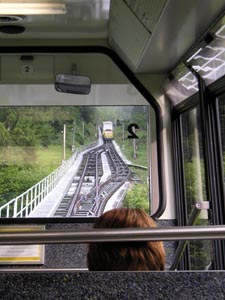
The passing zone on the incline railroad.
There was still some hiking to do to approach the Klettersteig. We felt like singing,"the hills come alive with the smell of cow pies." A great deal of the mountain landscape in Switzerland is used by cattle, cattle that turn grass into milk, meat,leather and money with a byproduct of fertilizer.
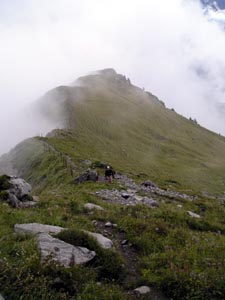
Martin steps carefully along the path.
The Kletterstieg began with a large information sign. We read it, noted that the clouds threatened us with rain, and decided to rope-up anyway. I didn't have gloves and after a day of repeatedly gripping the cold carabiners I knew I had to get some before my next climb.
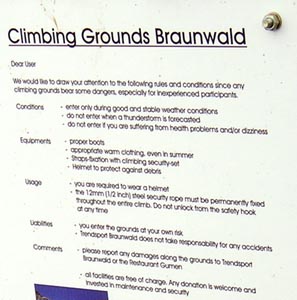
Click on this image to read the entire sign. In German!
The cables were in good condition and where the
climbing became steep large rebar handholds were bolted to the rock.
This allowed us to travel fast. 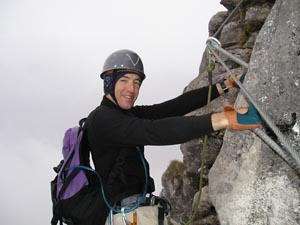
Martin shows how it is done, clipped in to the cable he is climbing
the rebar handholds.
We were soon at the top of the first Klettersteig.
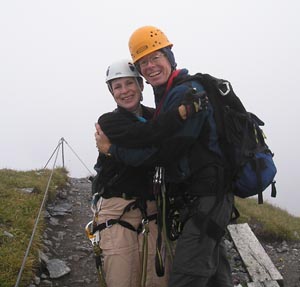
Morresa and I exchange a hug at the top of my first
klettersteig.
Klettersteigs are rated on a scale of difficulty from 0 to 5. This first one was level 3 and seemed easy. The next one was a 4, but before we could start up it the rain came. The way down was also a klettersteig!
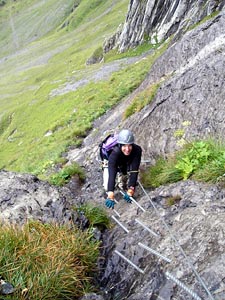
Martin leads us down the descent Kletterrsteig.
As we reached the base of the climbing we came to the Gumen restaurant, We popped in to get out of the rain and to get a bite of warm strudel with ice cream to celebrate. Maybe there is something to this European way of climbing?

We climbed the right hand ridge of the mountain above, and ate in the
Gumen restaurant.
We drove on to Lauterbrunnen deep in the valley beneath the Eiger. There is a klettersteig on the Eiger that we wanted to climb. But, like so many climbers before us, the Eiger was out of condition so we went hiking instead. We got to see the Eiger, the Monch, and the Jungfrau in between clouds. As a mountaineer I was pleased to see them, but I would have rather been climbing.
The rain continued and the waterfalls were running full, so we decided to go with the flow and visit a waterfall that had tunneled deep into the limestone cliffs, Trummelbach Falls. We got there just after they opened and managed to beat the hoards of tourists in busses. The water has carved wonderful smooth sinuous passages down into the core of the limestone cliff.

Paul wears raingear to the falls.
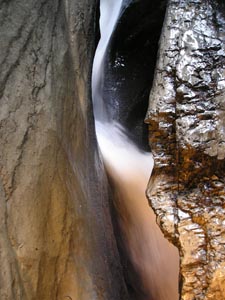
Water-carved, water-polished limestone.
Wet, we decided to rearrange our plans and head to Ausserberg Switzerland to climb to the Wiwani hut.
At first we walked along a road. The day was sunny and hot.
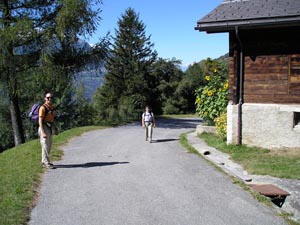
Martin and Morresa hiking to the Klettersteig Wiwani along a road at
first.
We left the road to hike along the historic Niwarch aqueduct. A narrow path was cut out of a cliff to bring water from the mountains to the villages below. At times the path was really narrow and there was a huge drop off down into a canyon. There were memorial plaques placed along the path to commemorate the deaths of people who had fallen off the path!
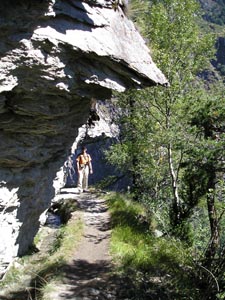
Martin hikes the narrow path next to the Niwarch aqueduct.
We saw some beautiful but deadly Amanita Muscara mushrooms growing alongside the aqueduct.
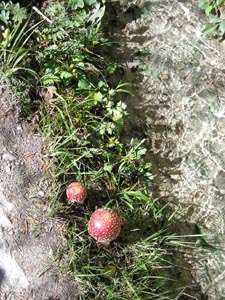
The water flows in the sun next to deadly fly agaric
mushrooms.
After a while we came to the Wiwani Klettersteig. It was a big one rising 1000 meters to the Wiwani hut. Since we were staying overnight we were carrying a little more gear than on our previous Klettersteigs. But we had a little practice now and made good time.
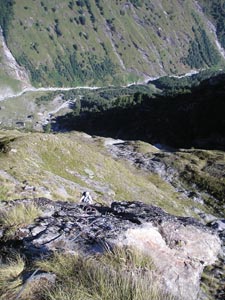
Morresa climbs the klettersteig 500 meters above the
stream.
There were some steep places where rebar handholds were drilled into the rock.

Martin goes first up the Wiwani Klettersteig using rebar
holds!
Finally just before sunset we arrived at the top of the ridge and gained a view of the Wiwani hut our home for the night.
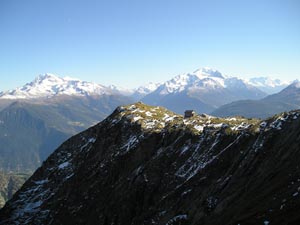
As the climb falls into shadow we spot the Wiwani hut and the distant
alps.
We had reserved a place in the hut so the hut warden made us a welcome hot dinner of Knorr soup and spaghetti and meatballs. We also had a bottle of wine made by the owner of the hut. After dinner two climbers from the Czech Republic joined us and we shared good climbing stories until bed time.
We slept upstairs on pads on the floor. We wrapped ourselves in our travel sheets and used comforters to keep warm. We slept well.
In the morning the hut loaned us their 11 mm rope and we went out to climb on the local climbing wall. I got to get a sense for the local ratings on fine rock. We also found that there was a long climb to the summit of the Wiwani horn up a ridge with a single 5.8 pitch. We'll have to climb that on our next trip.
With two Klettersteigs under our belt we decided to tackle the
hardest Klettersteig in Switzerland, The face of the Daubenhorn. A
grade 5 Klettersteig.
We took the cable car from Luekerbad up to the hotel. Once again we had dinner but went to bed early since we would get a predawn start tomorrow.
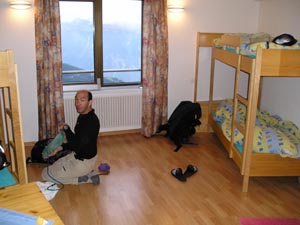
Martin prepares in the mountain hotel.
The route was twice as long and much harder than anything we had done so far, over 2000 m of climbing.

The cliffs of the Daubenhorn are too crumbly for a rock
route.
The route began with a long traverse out onto the steep part of the face.
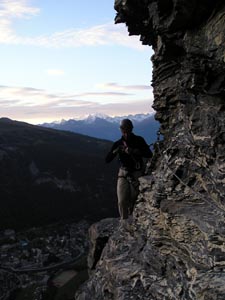
Martin is on the climb before sunrise.
There was one large party ahead of us. They looked tiny as they reached the vertical part of the route. W e were moving faster than they were and I wondered if we could pass them.
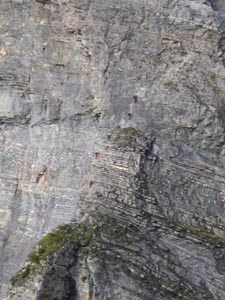
We're early but there is a crowd ahead of us.
The steep parts were fun. but the rock was crumbly and we had to be very careful to not knock loose any rocks.

Ladders climb up some steep sections.
Then we came to one of the most amazing places on any climb I have ever done. The route went in to a cave.
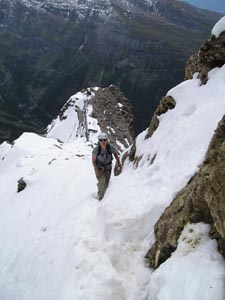
The upper part of the route is covered in snow!
The Matterhorn
Alas, we did not climb it, the weather was barely good enough to allow us a view.
We took the train to Zermatt among thousands of tourists.
Then we looked around for a hike, and ended up on the Marmot Hike!
What do you do when your mountains are infested with a plague of rodents? Make a trail for the tourists to find them and look at them! We followed the trail for part of our hike and worst of all we saw no marmotts.

No kidding a trail to watch marmotts!
We did see mountain goats.
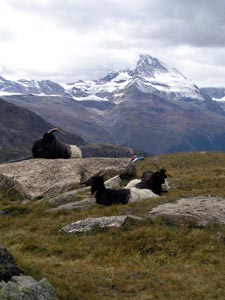
Mountain Goats and Matterhorn.
Much later in the hike the Matterhorn peaked out of the clouds. The Matterhorn is the vision people have when they think "alpine mountain" a glacially carved spire.
Saas Grund
Morresa was smart enough to get us out of Zermatt to a woonderful hostel in Saas Grund, a nearby valley with access to two great klettersteigs.
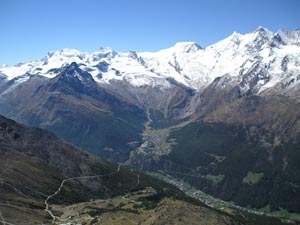
The town of Saas Grund nestled at the bottom of an alpine
valley.
We awoke to a beautiful day and took a ski lift up to the trail system. Ahead of us we spotted a party of twenty climbers, we guessed that they were heading to climb the same route we were and I wanted to pass them. We were slightly faster than they were but not fast enough to pass them. So I took Morresa's pack and invited her to lead us as fast as she could. She smiled and put on the speed. Pretty soon I was sweating and working hard to keep up. As we came up to the back of the large group I handed Morresa back her pack. The group stopped at picnic tables near a hut to have a drink of coffee and we were in perfect position to blast by them. Yay!
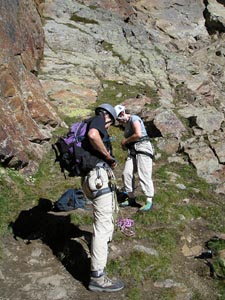
Martin and Morresa get into their harnesses.
We arrived at the base of the climb all by ourselves! Put on harnesses and helmets and stepped onto the hard, clean, steep rock.
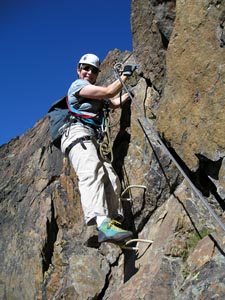
Morresa climbs with via ferrata protection.
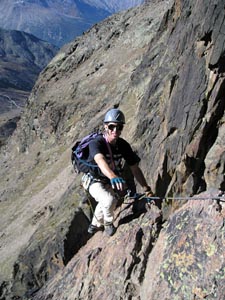
Martin climbs higher on the route.
When we reached the first summit and looked across to the main summit
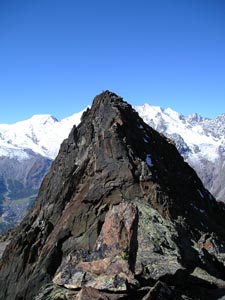
Looking to the main summit.
I was impressed because it looked like the route went straight up a steep smooth wall, after crossing a long "Hmalayan" two wire bridge. I felt like I needed to summon the ghosts of the flying Wallendas to cross the cables.
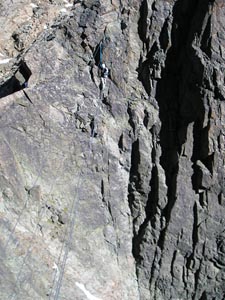
Morresa crosses the wire bridge.
There were two thick steel cables to walk on and two armpit high cables to grab with one overhead cabe to clip to with a sling an carabiner. It was a long way down too. The bridge made this a memorable climb.
Once across the bridge we came to an overhanging headwall. A cargo net hung down away from the wall. I wondered what could be next?
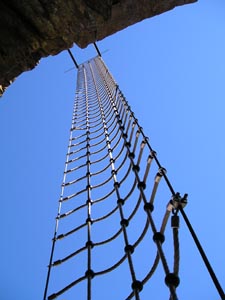
A cargo net up an ovrhanging wall.
At the top of the net we arrived at a vertical wall. I did a double take when I realized that large rocks had been bolted to the face to make it more easily climbable. It's funny that I didn't mind the rebar but I was shocked to find climbing gym holds bolted to a cliff.
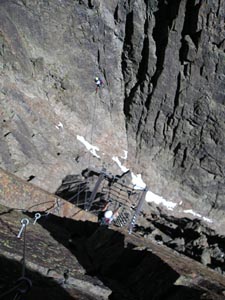
Morresa reaches the top of the cargo net as another climber crosses
the bridge.
This part of the klettersteig was new since our guidebook was printed, it was a KS4, the older route avoids the interesting bits and is KS3.

Martin crosses the knife edge ridge with klettersteig
protection.
We arrived at the summit just in time for lunch. Of course there was a large cross to mark the peak.
The next day we went across the valley to climb the Mittaghorn.
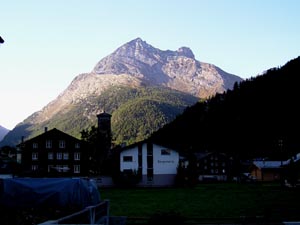
The Mittaghorn viewed from our Hostel the route follows the right
skyline.
The route is easier at KS3. We started out by bus to the higher town of Saas Fee. Then took a cable car and finally a lift to the beginning of the hike.

Larger peaks loom behind as we hike to the Mittaghorn
klettersteig.
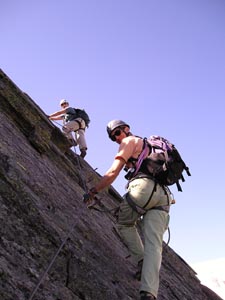
Morresa above Martin on the Mittaghorn.
The climbing was fun and mostly easy. Since we could all move independently we could climb at the same time and move fast. One rule of klettersteig climbing is that only one person at a time can be on the same length of cable. That way if the lead person falls they will not hit the person below.

The summit cross of the Mittaghorn.
We arrived on the summit at noon. A perfect time for the Mittaghorn which means midday summit, it also means lunch, so we ate.
Lunch each day consisted of local cheese or meat with local bread and of course swiss chocolate.
Back in the hotel Martin revelaed the secret of his fast hiking, socks built like gloves wuth fingers for each toe!
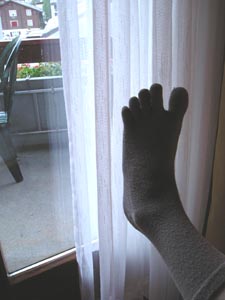
Martin shows off his foot gloves.
We were now done warming up in Switzerland it was time to head into danger and drive Italian roads!
Italy
|
Scientific Explorations with Paul Doherty |
|
1 November 2006 |